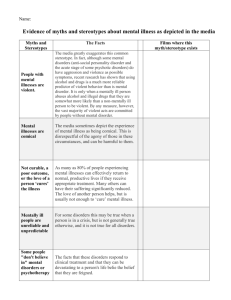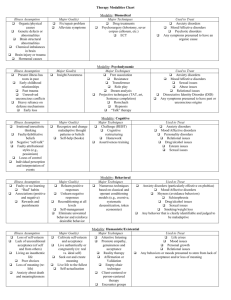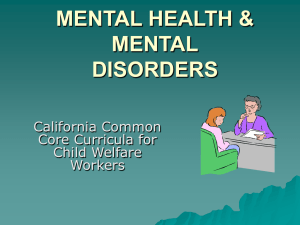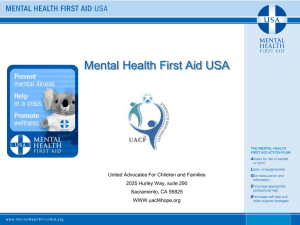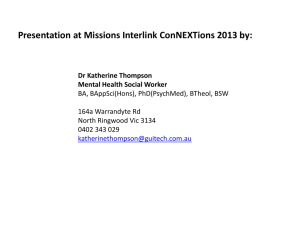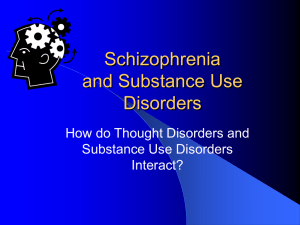National Mental Health Strategy - Capital Projects and Service
advertisement
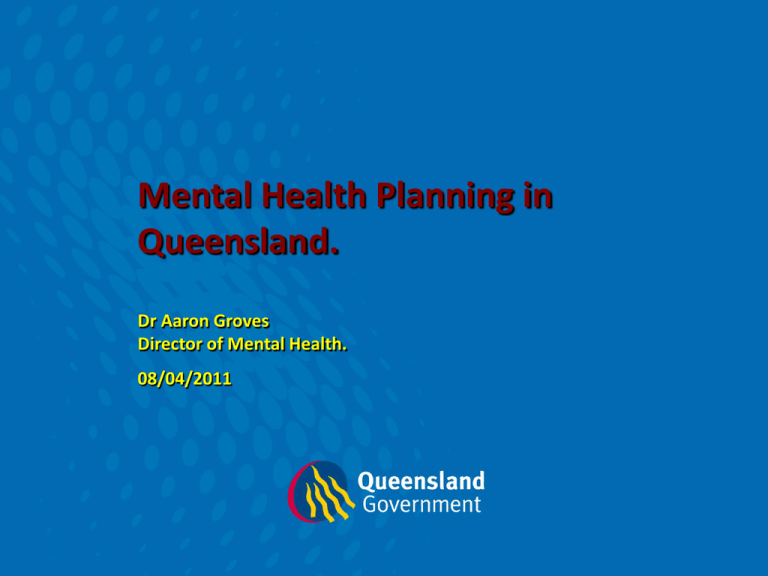
Mental Health Planning in Queensland. Dr Aaron Groves Director of Mental Health. 08/04/2011 • I would like to pay my respect and acknowledge the Wurundjeri, Boonerwrung, Taungurong, Djajawurrung and the Wathaurung people who make up the Kulin Nation the area we call Melbourne. • In addition I acknowledge the Turrbal people part and present on whose land I walk, I work and I live. National Mental Health Strategy • • • • • Mental Health Statement of Rights and Responsibilities 1991 National Mental Health Policy 1992 National Mental Health Plan, 1992–98 Medicare Agreements 1993-98 Second National Mental Health Plan,1998–03 Australian Health Care Agreements 1998-03 National Mental Health Plan 2003–08 Australian Health Care Agreements 2003-08 • COAG National Action Plan for Mental Health 2006-11 • National Mental Health Policy 2008 Fourth National Mental Health Plan 2009-14 • States and Territory mental health policies, plans and strategies Queensland Plan for Mental Health 2007-17 The Policy Context 2008 National Mental Health Policy: principles underpinning future mental health reform • To promote the mental health and wellbeing of the Australian community and, where possible, prevent the development of mental health problems and mental illness; • To reduce the impact of mental health problems and mental illness, including the effects of stigma on individuals, families and the community; • To promote recovery from mental health problems and mental illness; and • To assure the rights of people with mental health problems and mental illness, and to enable them to participate meaningfully in society. The national context Fourth National Mental Health Plan • Launched by Australian Health Ministers in November 2009 • Operationalises the revised National Mental Health Policy 2008 • 34 actions under 5 priority areas: 1. Social Inclusion and Recovery 2. Prevention and Early Intervention 3. Service Access, Coordination and Continuity of Care 4. Quality Improvement and Innovation 5. Accountability – Measuring and reporting progress The National Drug Strategy 2004-09 (in the process of being renewed) and associated strategies National Survey of Mental Health and Wellbeing 2007 • One in five Australians had experienced a mental illness in the last 12 months – 14.4% Anxiety disorders (panic disorders, agoraphobia, social phobias, GAD, OCD, PTSD) – 6.2% Affective disorders (depression, dysthymia, bipolar affective disorder) – 5.1% Substance use disorders (alcohol and other drugs) . • 45 % of Australians experience mental disorder at some point in their lifetime. • Under-estimate for a number of reasons – Household survey – Common mental disorders – Relatively low response rate. Scope of our challenge Mental illness • One quarter of the total disability burden due to mental illness • Third leading cause of overall disease burden after cardiovascular diseases and cancer • Almost half the population will experience a mental disorder in their lifetime, 1 in 5 in any 12 month period The ‘burden’ of mental health disorders on Australian society Cardiovascular Cancer Mental Nervous system Injury Chronic respiratory Musculoskeletal Years of life lost due to death Digestive Diabetes Genitourinary Years lost due to disability Infectious Congenital Respiratory infections Neonatal Other 0 100 200 300 400 Years of healthy life lost (thousands) 500 600 Scope of our challenge The vast majority of mental disorders have onset early in life Any Lifetime ICD-10 Mental Disorder: Cumulative Proportion of Cases by Age of On Cumulative percent 100% 75% 50% 64% have onset by age 21 years 25% 0% 1 11 21 31 41 51 61 71 82 Age of Onset (years) Cum%: Any Anxiety or Affective Di Treated prevalence • Only around one-third (35% or 3.2 million people) who were assessed as having a 12-month mental disorder accessed services for mental health problems – 41% women with disorders compared with 28% of men – Highest treatment rates were for affective disorders with 45% – Half of those who received services (51.7%) had two or more disorders. – Two-thirds with mental disorder and a suicidal behaviour • Of those with 12-month disorders who received services, their needs were only partially or not met – – – – – information (28.6%) medication (9%) counselling (25.7%) social intervention (23.6%) skills training (17.9%) Why people aren’t receiving services? • Most report no need Of those with 12-month disorders who didn’t receive services: – 94.4% reported no need for information; – 97.9% reported no need for medication; – 89.7% reported no need counselling; – 94.3% reported no need for social intervention; and – 96.4% reported no need for skills training. Key messages • Proportion of the population receiving services has not changed much since 1997 • Appears we are providing services differently – greatly increased servicing by psychologists – perhaps more people seeing GP+ • Messages seem to have got through for depression, particularly to middle aged – Not doing so well for other disorders, young and men • Many people who could benefit from effective treatments report that they don’t need services – need to look at stigma and mental health literacy – as well as disseminating treatment information (effectiveness, availability, cost, access) Scope of our challenge Alcohol and drugs • One fifth of total injury burden in Queensland is due to excessive alcohol consumption • 1 in 10 adults drink at levels placing them at risk of long term harm • This rises to 1 in 5 in the 18-24 age group • Alcohol related expenditure $15.3 billion nationwide in 2004/05, 13% in healthcare system • 1 in 7 Queenslanders used illicit drugs in the past year • Again, this rises to 1 in 3 in the 20-29 year age group Scope of our challenge Suicide • More than 1 in 8 Australian adults contemplate suicide in their lifetime • 500 completed suicides in Queensland each year • 2nd leading cause potential years of life lost for males, 4th for females • Estimated economic cost of up to $17.5 billion per annum nationwide Physical illness and mental illness the facts: Largest data linkage study of its type in Australia: •231,311 people, who were on the mental health register had their records between 1980-1998 examined •There records were compared with the rest of the population •There life expectancy was 12 years shorter than the rest of the population, that is it was the same as Aboriginal people in WA THEY FOUND THAT SUICIDE WAS NOT THE MAIN CAUSE OF CLIENT MORTALITY, BUT THE FIFTH-HIGHEST CAUSE. (1) Malignant neoplasms (3) Acute myocardial infarction (2) Cerebrovascular disease (4) Other circulatory system (5) Suicide Source: Lawrence D, Coghlan R. H health inequalities and the health needs of people with mental illness. NSW Public Health Bulletin 2002; 13(7): 155– 158. Physical illness and mental illness the facts: •Very high rates of smoking and therefore much higher rates of respiratory disease •Higher rates of deficiency anaemias •Higher rates of injury particularly being inflicted by others •Ischaemic Heart Disease caused twice the number of excess deaths than suicide •Yet lower rates of revascularization •Lower rates of hospitalization •Higher rates of surgical complications Inpatient Mental Health services So what is happening to our beds? 12,000 Pre-Strategy Post-Strategy 10,000 8,000 6,000 4,000 2,000 0 1986 1988 1990 1992 1994 1996 1998 2000 2002 Inpatient Mental Health Services But… It started a long time ago! Note - this is ALL beds, not just stand alones 30,000 25,000 PreStrategy PostStrategy 20,000 15,000 10,000 5,000 19 65 19 67 19 69 19 71 19 73 19 75 19 77 19 79 19 81 19 83 19 85 19 87 19 89 19 91 19 93 19 95 19 97 19 99 20 01 20 03 0 Trends in availability of psychiatric beds in Western Europe Psychiatric hospital beds per 100000 500 400 Austria Belgium Cyprus Denmark Finland France Germany Greece Iceland Ireland Italy Luxembourg Malta Netherlands Norway Portugal Spain Sweden United Kingdom 300 200 100 Source WHO 0 1970 1980 1990 2000 2010 Trends in availability of psychiatric beds in Central and Eastern Europe (CEE) Psychiatric hospital beds per 100000 250 200 Bulgaria Croatia Czech Republic Estonia Hungary Latvia Lithuania Poland Romania Slovakia Slovenia TFYR Macedonia Turkey 150 100 50 Source WHO 0 1970 1980 1990 2000 2010 1. Expenditure Per capita expenditure by states and territories on general adult mental health services 2002-03 (dollars) 125.81 WA 112.22 ACT 110.81 NSW 107.88 SA 102.08 TAS NT VIC QLD 98.92 96.97 89.95 Nat. Av. $104.34

